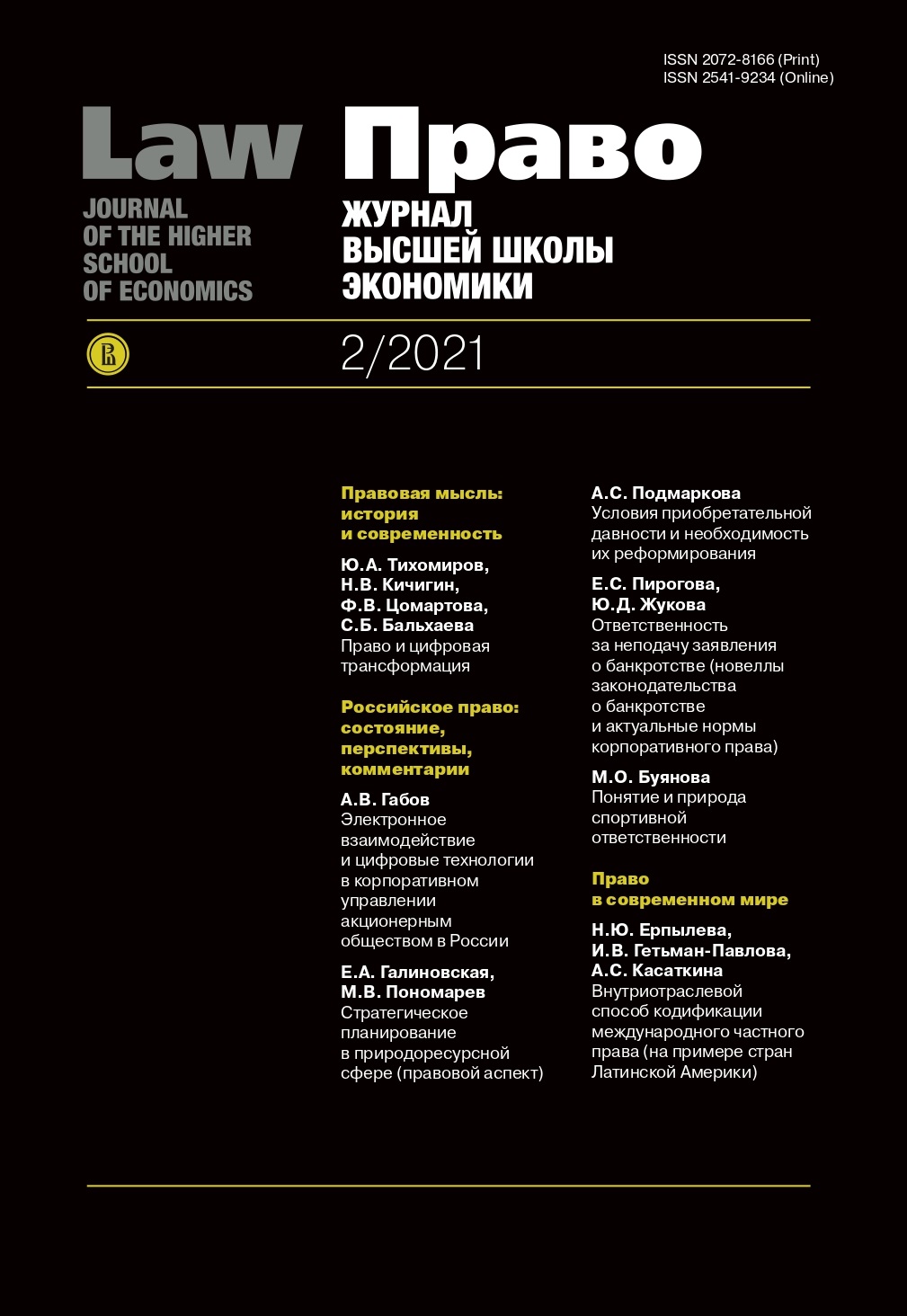Внутриотраслевой способ кодификации международного частного права (на примере стран Латинской Америки)
Аннотация
Кодификация законодательства по международному частному праву (МЧП) - процесс, представляющий структурное и содержательное упорядочивание правовых норм для систематизации и оптимизации регулирования частноправовых отношений, имеющих юридически значимую связь с правопорядками двух и более стран. В качестве способов кодификации МЧП целесообразно обозначить следующие. Внутриотраслевая кодификация — в акт общей кодификации гражданского права включается особый раздел, регламентирующий большую часть институтов МЧП. В рамках данного способа выделяются две основные формы его результата: а) простая внутриотраслевая форма — регулирование вопросов общей части МЧП и правил выбора применимого права вынесено в отдельный раздел ГК. Нормы МГП закрепляются в актах кодификации гражданского процессуального права; б) комплексная внутриотраслевая форма — в акт кодификации гражданского права включаются институты общей части МЧП, коллизионные нормы и нормы МГП (юрисдикционные и процессуальные правила). При межотраслевой кодификации в акт общей кодификации гражданского права включается особый раздел, содержащий основные нормы и институты МЧП. Отдельные институты особенной части МЧП включаются как самостоятельные разделы в акты специальных отраслевых кодификаций. Автономная отраслевая кодификация — издание специального закона, кодифицирующего общие положения и коллизионные нормы МЧП. Комплексная автономная кодификация (полномасштабная кодификация МЧП/МГП) — издание отдельного закона или кодекса, содержащего как основные принципы и коллизионные нормы МЧП, так и основные правила МГП. Современный законодатель демонстрирует все многообразие форм и способов кодификации МЧП, при этом полезно рассмотреть предпочтения тех или иных стран. Для анализа избрано законодательство стран Латинской Америки, где процессы кодификации МЧП идут чрезвычайно активно. Сделан вывод, что большинство латиноамериканских стран выбирают путь внутриотраслевой кодификации МЧП (ее простую или комплексную форму). Такой способ кодификации не свободен от недостатков; оптимальным вариантом является автономная комплексная кодификация, имеющая трехчастную структуру: 1) международная юрисдикция; 2) применимое право; 3) признание/исполнение иностранных судебных и арбитражных решений. В исследовании использованы методы формальной логики, сравнительного правоведения и исторический метод.
Литература
Albán J. (2012) La ley aplicable a los contratos internacionales. International law. Revista Colombiana de Derecho Internacional, vol. 21, p. 120.
Araujo N., Guedes de C. Saldanha F. (2013) Recent developments and current trends on Brazilian private international law concerning international contracts. Panorama of Brazilian Law, no 1, pp. 73-83.
Arroyo D. (2016) Main characteristics of the new private international law of the Argentinian Republic. Rabels Zeitschrift für Ausländisches und Internationales Privatrecht, Bd. 1, S. 130-150.
Belikova K.M. (2010) Legal regulation of trade and codification of private law in Latin American states. Moscow: Justitsinform, 480 p. (in Russian)
Bogdan M. (2012) Private international law as component of the law of the forum. Leiden: Brill, 360 p.
Inshakova A.O. (2011) Private international law. Moscow: RUDN, 374 p. (in Russian)
Kalensky P. (1971) Trends of private international law. Prague: Academia, 308 p.
Kiestra L.R. (2014) The Impact of the European Convention on Human Rights on Private International Law. The Hague: Asser Press, 340 p.
Kisil V. (2012) National legislation as a source of private international law. Dovgert A.S., Kisil V.I. (eds.) Private international law. Kiev: Alerta, 376 p. (in Ukranian)
Kisil V. (2014) Modern trends in codification of private international law. Pravo Ukraini, no 2, pp. 89-104 (in Ukranian)
Krutij E.A. (2012) Modern codifications of private international law. Candidate of Juridical Sciences Thesis. Moscow, 236 p. (in Russian)
Kunda I., Gonçalves C. (2010) Practical handbook on European private international law. Civil Justice Programme, 152 p.
Lebedev S.N., Kabatova E.V. (eds.) (2011) Private international law. Moscow: Statut, 400 p. (in Russian)
Lunz L.A. (2002) Course of private international law. Moscow: Spark, 1007 p. (in Russian)
Maekelt T. (1982) General rules of private international law in the Americas: new approach. Collected Courses of the Hague Academy of International Law, vol. IV, pp. 193-380.
Mota C. (2014) Una aproximación internacional privatista al nuevo código de procedimiento civil de Bolivia de 2013. Revista Boliviana de Derecho, vol. 18, pp. 16-63.
Ortiz de la Torre J. (2020) El nuevo Derecho internacional privado de Puerto Rico: breve nota acerca del sistema conflictual del Título preliminar del Código Civil 1 de junio de 2020. Anales de la Real Academia de Doctores de España, no 2, pp. 261-278.
Parise A. (2017) The Argentine civil and commercial code of 2015: igniting third generation of codes for Latin America. Zeitschrift für Europäisches Privatrecht, Bd. 3, S. 339-668.
Prosser W. (1953) Interstate publication. Michigan Law Review, no 7, pp. 959-1000.
Rafalyuk E.E. (2010) Unification of private international law in Latin America states. Zhurnal rossiyskogo prava, no 5, pp. 88-98 (in Russian)
Rühl G., von Hein J. (2015) Towards a European code on private international law? Rabels Zeitschrift für Ausländisches und Internationales Privatrecht, no 4, S. 701-751.
Sadikov O.N. (1962) Conflict in agreements on international rail cargo transportation. Soviet Yearbook of International Law, 1961. Moscow: Academy of Sciences, 529 p. (in Russian)
Silva J. (2018) Construyendo una ley de Derecho internacional privado para México. Anuario Espanol de Derecho Internacional Privado, vol. 18, pp. 703-718.
Sivitsky V.A. (ed.) (2010) Systematization of legislation. Moscow: HSE Publishers, 535 p. (in Russian)
Skakun O.F. (2000) Theory of state and law. Har'kov: Konsum, 704 p. (in Russian)
Shushkanov P.A. (2020) Compliance with the principles of pandect codification in structure of the Russian Civil Code. Mirovoi sudya, no 2, pp. 32-35 (in Russian)
Tille A.A. (1965) Time, space, law. Moscow: Juridicheskaya literatura, 1965. 203 p. (in Russian)
Tiburcio C. (2013) Private international law in Brazil: a brief overview. Panorama of Brazilian Law, no 1, pp. 11-37.
Tuininga K. (2009) Cuban private international law: some observations, comparisons, and suppositions. University of Miami Inter-American Law Review, no 3, pp. 433-452.
Vargas J. (2005) The Federal Civil Code of Mexico. University of Miami Inter-American Law Review, no 2-3, pp. 229-247.
Velasco I. (1989) El sistema de derecho internacional privado en la republica de Cuba. Revista espanjola de derecho internacional, no 2, pp. 669-674.
Vial M. (2020) International contracts in Latin America: historical slow pace towards the acceptance of party autonomy in choice of law. Revista de Derecho Privado, no 38, pp. 241-276.
Vizcarra A. (2012) Derecho internacional privado en el sistema interamericano. Conferencia pronunciada el seminario de AMEDI. México: University, 23 p.
Zenin I.A. (2021) Civil and commercial law of foreign states. Moscow: Yurait, 227 p. (in Russian)
Zlatescu I., Belu M. (2012) La culture juridique et l'acculturation du droit (rapport national roumain). Legal culture and legal transplants. 18th International Congress of Comparative Law. J. Sánchez Cordero (ed.). Washington: GPO, pp. 859-876.
Zytkiewicz N. (2017) Codification of private international law in Argentina. Kwartalnik prava privatnego, no 2, pp. 297-335 (in Polish)
Copyright (c) 2021 Право. Журнал Высшей школы экономики

Это произведение доступно по лицензии Creative Commons «Attribution-ShareAlike» («Атрибуция — На тех же условиях») 4.0 Всемирная.


















